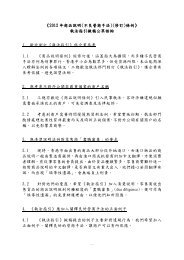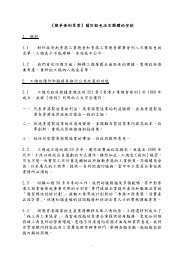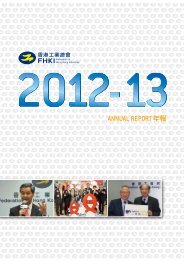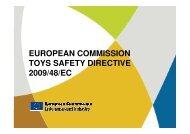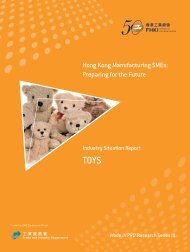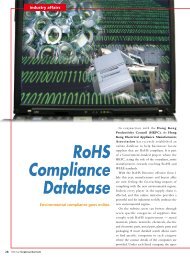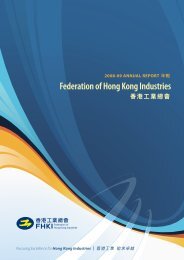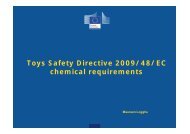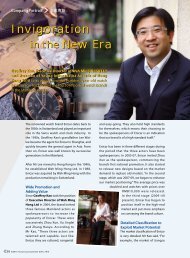Hong Kong Manufacturing SMEs: Preparing for the Future
Hong Kong Manufacturing SMEs: Preparing for the Future
Hong Kong Manufacturing SMEs: Preparing for the Future
- No tags were found...
Create successful ePaper yourself
Turn your PDF publications into a flip-book with our unique Google optimized e-Paper software.
84The company will invest in research anddevelopment, concentrating particularly on <strong>the</strong>development of new manufacturing methodologyand on improved machine facilities. Datamaticplans to install more new facilities and more highendmilling machines. The investment patternduring <strong>the</strong> last few years has been to reinvest a percentage of company sales revenue into researchand development and <strong>the</strong> establishment of newfacilities. This practice will continue into <strong>the</strong> futuresince <strong>the</strong> old machines depreciate fast and <strong>the</strong>technology changes fast.Datamatic is considering setting up a subsidiaryin <strong>the</strong> YRD to support its clients in that part ofChina. The company does not envision movingmanufacturing wholesale to <strong>the</strong> YRD, but it cansee <strong>the</strong> merit in considering expanding into <strong>the</strong>YRD so as to have a presence <strong>the</strong>re alongsidemajor clients. Datamatic does not plan tomanufacture outside of China. The company isoptimistic about <strong>the</strong> Chinese automobile marketand about <strong>the</strong> opportunities <strong>for</strong> growth in itsniche. Datamatic enlarged <strong>the</strong> size of its plantin 2005 and purchased more equipment. Thesechanges allow <strong>for</strong> fur<strong>the</strong>r product diversificationwhich will make Datamatic more competitive. TheCompany plans stay at <strong>the</strong> <strong>for</strong>efront of advancesin technology and it will continue to focus onmanufacturing high-end products <strong>for</strong> automobilelighting components.Datamatic aims to be a sustainable manufacturerand to maintain a harmonious relationship with <strong>the</strong>communities in which it operates. The companyis committed to environmental protection so as toprovide <strong>for</strong> a better future <strong>for</strong> all people and to thisend it has invested in a waste recycling system toreduce pollution and to be able to claim status asan environmentally friendly firm.Lessons from <strong>the</strong> Datamatic CaseThere are a number of lessons that can be learnedfrom <strong>the</strong> Datamatic case.• Firms in <strong>the</strong> sector need to learn to expect andanticipate changes in market, technology, andbusiness environment, and be ready to adaptquickly in <strong>the</strong> ways that are needed to survive.• <strong>Hong</strong> <strong>Kong</strong> firms must demonstrate <strong>the</strong>ir valueto customers that are considering taking <strong>the</strong>irmould and die work in-house by emphasising <strong>the</strong>advantages that accompany sourcing externally,<strong>the</strong> expertise that a specialist company canprovide, a willingness to better understand andanticipate customer needs, and opportunities toengage in <strong>for</strong>ms of business collaboration.• Firms should diversify customer risk by developingrelationships with more multiple customers inmultiple geographic markets and in multipleindustries.• <strong>Hong</strong> <strong>Kong</strong> firms operating in <strong>the</strong> PRD facehigher materials costs than many of <strong>the</strong>irMainland competitors as well as potentialmaterial shortages because non-local companiesare required to import some of <strong>the</strong> criticalmaterials that are used in production.• Since <strong>SMEs</strong> in <strong>the</strong> mould and die industry usespecialised labour that can be attracted away bycompetitors or can leave to set up firms of <strong>the</strong>irown, <strong>the</strong> <strong>SMEs</strong> need to have means of attractingand retaining key personnel.• Firms can combat labour shortages by payinghigher wages and offering better conditions andbenefits to workers than competing firms.• <strong>SMEs</strong> may consider moving <strong>the</strong>ir manufacturingoperations to o<strong>the</strong>r locations, such as <strong>the</strong> YRD,where competition <strong>for</strong> skilled workers is lessintense at present and where costs are lower ingeneral.• <strong>SMEs</strong> should identify and take advantage ofincentives and policy measures that are put inplace by authorities in Mainland China. Thesewill be different across different locations andwill have time-limits. <strong>SMEs</strong> will need to do <strong>the</strong>irhomework to figure out which incentives bestsuit <strong>the</strong>m.




